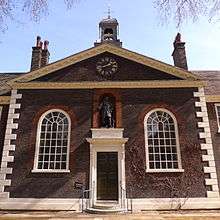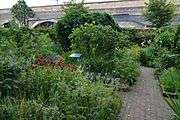Museum of the Home
The Museum of the Home, formerly the Geffrye Museum,[1] is a museum in the Geffrye Almshouses on Kingsland Road in Shoreditch, London. It explores home and home life from 1600 to the present day with a series of period room displays.[2]
 Museum façade | |
 Location of the Museum of the Home in London | |
| Established | 1914 |
|---|---|
| Location | Geffrye Almshouses 136 Kingsland Road London, E2 United Kingdom |
| Coordinates | 51.531742°N 0.076630°W |
| Visitors | 120,000 (annually) |
| Director | Sonia Solicari |
| Public transit access | |
| Website | Museum of the Home |
The museum is housed in 18th-century Grade I-listed almshouses, formerly belonging to the Ironmongers' Company.[3] These were built in 1714 thanks to a bequest by Sir Robert Geffrye, a former Lord Mayor of London and Master of the Ironmongers' Company.[4]
Several structures connected with the Museum are listed on the National Heritage List for England. The main museum building is Grade I listed and the niche in the northwest corner of the forecourt of the Museum is listed Grade II*.[5][6] The forecourt wall, gates and railings to the Museum are Grade II* listed, and the two K6 telephone boxes on the Kingsland Road outside the Museum are listed Grade II.[7][8][9]
In January 2018, the museum closed for a two-year £18m development project, and is due to reopen in 2020.[10] Until this closure, the main permanent displays were a series of room settings furnished and decorated to show the main living spaces and elements of domestic life through the centuries, reflecting changes in society, behaviour, style and taste.[11] The museum's change of name was announced in 2019.[12]
Slave Trader Statue Controversy
Following on from the Black Lives Matter protests around the country, and removal of slave trader statues of Edward Colston in Bristol, and the Statue of Robert Milligan in Tower Hamlets, the museum came under pressure to remove their own statue of the slave trader Robert Geffrye which is placed in pride of place above the main doors in their gardens. Over 4000 people signed a public petition calling on them to remove the statue.
In July 2020 the museum controversially decided to ignore the results of a public consultation that they had commissioned. In their public statement, the museum said "Overall, the response was in favour of removing the statue." however "Board of Trustees decided not to remove the statue."
Gallery
 Front facade
Front facade Herb garden
Herb garden Rear facade and garden
Rear facade and garden Garden reading room
Garden reading room Chapel
Chapel 1870 drawing room
1870 drawing room 1998 loft apartment
1998 loft apartment 20th Century galleries
20th Century galleries.jpg) Period gardens
Period gardens
References
- Brown, Mark (27 November 2019). "Geffrye to reopen as Museum of the Home after £18m overhaul". The Guardian.
- "Museum of the Home".
- Haslam, Kathy (2005). A History of the Geffrye Almshouses. London: Geffrye Museum. ISBN 1872828108.
- Hunting, Penelope (2013). Riot and Revolution: Sir Robert Geffery 1613–1704. London: Geffrye Museum. ISBN 1872828140.
- Historic England, "Niche in the north west corner of the forecourt of the museum (1265687)", National Heritage List for England, retrieved 5 July 2017
- Historic England, "Geffrye Museum (1226772)", National Heritage List for England, retrieved 5 July 2017
- Historic England, "Forecourt wall, gates and railings to the Geffrye Museum (1265688)", National Heritage List for England, retrieved 5 July 2017
- Historic England, "K6 telephone kiosk, outside Geffrye Museum (1235680)", National Heritage List for England, retrieved 5 July 2017
- Historic England, "K6 telephone kiosk, outside Geffrye Museum (1235681)", National Heritage List for England, retrieved 5 July 2017
- "About the development". Museum of the Home.
- "About the museum". Museum of the Home.
- Sanderson, David (27 November 2019). "Tongue-twister Geffrye museum of the home clears its name". The Times.